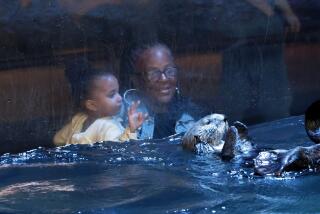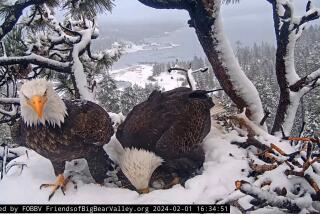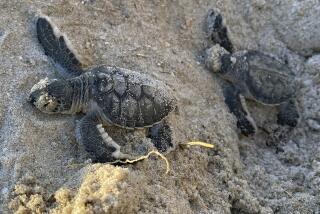Saving sea turtles one egg at a time
- Share via
Reporting from Gulf Shores, Ala. — Is it possible to save a generation without breaking any eggs?
That’s the tricky question the U.S. Fish and Wildlife Service, FedEx and hundreds of volunteers are beginning to answer this week as they dig up more than 70,000 turtle eggs on the gulf shore and transport them to the oil-free beaches of Cape Canaveral, Fla., where they’ll be hatched in a warehouse and released into the ocean.
It’s one of the most ambitious wildlife nest relocations ever attempted, biologists said, a risky experiment to prevent widespread mortality of five threatened and endangered turtle species.
“This is the largest egg translocation ever done in the U.S., and possibly in the world,” said Michelle Pico, director of marine programs at the National Fish and Wildlife Foundation. “It’s a grand experiment.”
Plans call for digging up hundreds of turtle nests on the Florida Panhandle and 80 in Alabama, each containing about 100 ping-pong sized eggs. Biologists layer the eggs and wet sand in Styrofoam coolers and load them onto customized, shock-absorbent wood pallets that are transported hundreds of miles in a giant FedEx truck.
Success is far from guaranteed. Truck vibrations could damage the fragile eggs. The embryos might detach from the eggs, or their shells could break. The turtles may not react well to the warehouse in Cape Canaveral. Hatchlings could be eaten as soon as they swim into the turquoise waters of the Atlantic.
“The sheer logistical challenges associated with it add a lot of uncertainty,” said Michael Ziccardi, a veterinarian at UC Davis who is coordinating sea turtle and marine mammal rescue efforts in the gulf.
But there isn’t much of a choice. Leaving the eggs to hatch on oil-splattered Gulf of Mexico beaches, where baby turtles the size of limes would crawl into oil-tinged waters, will result in certain death, biologists concluded.
For nearly three months the busted BP oil well has been gushing up to 60,000 barrels a day, polluting vast stretches of shoreline during critical turtle nesting season.
Nests have been moved in the past to save eggs from hurricanes or high tides, but are rarely moved such a great distance, said David Godfrey, executive director of the Sea Turtle Conservancy, a nonprofit rescue group in Florida. Moving a nest has been shown to decrease the number of turtles that survive by about 10%, although that number comes from studies in which the eggs are moved right after they are laid.
Baby turtles typically swim into the sea and feast on sargassum, seaweed that in the gulf is now soaked with oil. So far this year, biologists have found 463 dead sea turtles, although only 14 were visibly oiled. Ziccardi said it is not yet known if the deaths are related to the spill. Six turtle nests were lost in the high waters of tropical storm Alex.
Even in good conditions, only about 1 in 1,000 turtles survive to adulthood. Some that hatch near developed coastal areas crawl toward the bright lights of civilization and become disoriented and never make it to sea. Others get tangled in fishing nets.
An organization called Share the Beach recruits volunteers to find and protect turtle nests along 47 miles of beach in Alabama during egg-laying months, roughly May through October.
Dozens of the group’s volunteers, clad in bright green shirts and caps, watched this week as their team leader, Sherry Parks, and wildlife biologist Bruce Porter extracted 127 turtle eggs from a nest on a windy Alabama beach dotted with pastel cottages.
Porter donned blue plastic gloves and used his hands to dig a basketball-size hole in the fine white sand, gingerly feeling for the eggs, which were packed 2 feet down. He marked each white egg with a grease pen, indicating which side was the top. Parks cautiously lifted the eggs into a cooler, where they were was packed with other eggs from the nest.
Another volunteer, who was wearing a turtle-shaped whistle around her neck, scooped sand from the beach and into the cooler to ensure that the eggs would be incubated in grains from their home turf.
The nest — like others found along this beach lined by seafood restaurants and homes on stilts — was cordoned off by green tape. A yellow sign warned people to stay away from the nesting grounds. Yet dozens of gaping tourists watched the excavation from behind a fence as children in bathing suits frolicked nearby in the ocean.
The coolers, akin to a convenience store ice chest, were packed on pallets in a temperature-controlled FedEx big rig and trucked to Florida.
Ron and Margaret-Mary Shellito, the husband-and-wife team driving the 1,000-plus miles back and forth to Cape Canaveral, have driven NASA’s Mars Rover and government missiles while working for the transport firm. But they have never handled turtle eggs.
They take turns sleeping in the small bed in the back of the cab and eat meals from a microwave.
“Maybe someday down the line our grandchildren can say we were part of saving a species,” Margaret-Mary Shellito said.
The eggs are left in their coolers and incubated in a climate-controlled warehouse until they hatch and are released into the sea, said Dianne Ingram, a biologist with the U.S. Fish and Wildlife Service.
There’s no way to know whether the conditions in the eastern Atlantic will be too different from the gulf for the turtles to survive. Instinctively, mature female turtles return to the shores where they hatched to lay their eggs. Scientists don’t know whether this generation of cooler-hatched turtles will know where to return in about 18 years.
Hatchlings have already emerged from a nest delivered earlier, said Jane A. Provancha, the contractor running the warehouse operation. On Saturday and Monday evenings, she released 56 baby turtles into the dark waters of the Atlantic and watched them swim away. Turtles from about 83% of the eggs in the first nest have emerged and swum out to sea, she said.
“They looked really great. They were a little slow at first, but then they started moving around,” she said.
Added Pat Behnke, a spokeswoman for the Florida Fish and Wildlife Conservation Commission, said the release included 22 endangered Kemp’s Ridley hatchlings.
“There’s a fighting chance,” Behnke said. “We know 22 Kemp’s Ridleys have a good chance of surviving.”
More to Read
Sign up for Essential California
The most important California stories and recommendations in your inbox every morning.
You may occasionally receive promotional content from the Los Angeles Times.











